Analysis of Multiangle Wheat Density Effects Based on Drill Single-Seed Seeding
Abstract
1. Introduction
2. Materials and Methods
2.1. Experimental Design
2.2. Plant Indicators
2.3. Statistical Analysis
3. Results
3.1. Influence of Planting Density at the Population Level on Wheat
3.2. Influence of Planting Density at the Individual Level on Wheat
3.3. Influence of Planting Density at the Stem Panicle Level on Wheat
4. Discussion
4.1. Suitable Support for Analyzing Group Density Effects
4.2. Planting Density’s Effect on Population Level
4.3. Planting Density’s Effect on an Individual Level
4.4. Planting Density’s Effect on Organ Level
5. Conclusions
Author Contributions
Funding
Institutional Review Board Statement
Data Availability Statement
Acknowledgments
Conflicts of Interest
References
- Buczek, J.; Migut, D.; Jańczak-Pieniążek, M. Effect of Soil Tillage Practice on Photosynthesis, Grain Yield and Quality of Hybrid Winter Wheat. Agriculture 2021, 11, 479. [Google Scholar] [CrossRef]
- Woźniak, A.; Rachoń, L. Effect of Tillage Systems on the Yield and Quality of Winter Wheat Grain and Soil Properties. Agriculture 2020, 10, 405. [Google Scholar] [CrossRef]
- Gawęda, D.; Haliniarz, M. Grain Yield and Quality of Winter Wheat Depending on Previous Crop and Tillage System. Agriculture 2021, 11, 133. [Google Scholar] [CrossRef]
- Iqbal, M.M.; Khan, I.; Chattha, M.U.; Hassan, M.U.; Iqbal, M.; Farooq, M. Performance of Wheat Cultivars Under Different Tillage and Crop Establishment Methods. Int. J. Plant Prod. 2021, 16, 287–297. [Google Scholar] [CrossRef]
- Kashkool, H. Effect of Seed Size and Cultivation Method in the Growth Andyield of Wheat (Triticum Aestivum). Plant Arch. J. 2021, 21, 1262–1265. [Google Scholar] [CrossRef]
- Megerssa, S.; Beaugendre, T.; Bekele, N. Influence of Seed Rate and Row Spacing on Seed Multiplication Factor and Yield of Durum Wheat in Ethiopia. Agrosyst. Geosci. Environ. 2023, 6, e20373. [Google Scholar] [CrossRef]
- Limochi, K.; Farahvash, F.; Davodi, S.; Fateminik, F. The impact of different planting methods on yield and cluster characters wheat (cultivar of chamran) under different conditions of irrigation in the northern khuzestan climate. Int. J. Adv. Biol. Biomed. Res. 2014, 2, 2038–2044. [Google Scholar]
- Hussain, M.; Farooq, S.; Jabran, K.; Ijaz, M.; Sattar, A.; Hassan, W. Wheat sown with narrow spacing results in higher yield and water use efficiency under deficit supplemental irrigation at the vegetative and reproductive stage. Agronomy 2016, 6, 22. [Google Scholar] [CrossRef]
- Shao, M.; Sun, L.; Zhao, K.; Xu, X.; Huang, L.; Wang, L.; Yan, L.; Ju, Z. Effects of different line spacing and seedling belt width on yield formation of broad-width fine sowing wheat. Agric. Biotechnol. 2020, 9, 29–33. [Google Scholar] [CrossRef]
- Korohou, T.; Okinda, C.; Li, H.; Cao, Y.; Nyalala, I.; Huo, L.; Potcho, M.; Li, X.; Ding, Q. Wheat grain yield estimation based on image morphological properties and wheat biomass. J. Sens. 2020, 2020, 1571936. [Google Scholar] [CrossRef]
- Korohou, T.W.; Okinda, C.; Ding, Q.; Li, H.; Torotwa, I. Effect of no-till precise seeding on wheat (Triticum aestivum L.) population quality at the emergence stage. J. Anim. Plant Sci. 2022, 32, 186–198. [Google Scholar] [CrossRef]
- Tokatlidis, I.S. Addressing the yield by density interaction is a prerequisite to bridge the yield gap of rain-fed wheat. Ann. Appl. Biol. 2014, 165, 27–42. [Google Scholar] [CrossRef]
- Ding, J.; Li, F.; Le, T.; Xu, D.; Zhu, M.; Li, C.; Zhu, X.; Guo, W. Tillage and seeding strategies for wheat optimizing production in harvested rice fields with high soil moisture. Sci. Rep. 2021, 11, 119. [Google Scholar] [CrossRef] [PubMed]
- Hasan, A.; Carrasco-G, F.; Lizana, X.; Calderini, D. Low Seed Rate in Square Planting Arrangement Has Neutral or Positive Effect on Grain Yield and Improves Grain Nitrogen and Phosphorus Uptake in Wheat. Field Crops Res. 2022, 288, 108699. [Google Scholar] [CrossRef]
- Hemmat, A.; Eskandarib, I. Conservation tillage practices for winter wheat-fallow farming in the temperate continental climate of northwestern Iran. Field Crops Res. 2004, 89, 123–133. [Google Scholar] [CrossRef]
- Zhao, L.; Li, M.; Zheng, D.; Gu, C.; Na, Y.; Xie, B. Effects of irrigation methods and rice planting densities on yield and photosynthetic characteristics of matter production in cold area. Trans. Chin. Soc. Agric. Eng. 2015, 31, 159–169. [Google Scholar]
- Wang, F.; Wang, X.; Sayre, K. Comparison of conventional, flood irrigated, flat planting with furrow irrigated, raised bed planting for winter wheat in China. Field Crops Res. 2004, 87, 35–42. [Google Scholar]
- Zuo, Q.; Kuai, J.; Yang, S.; Cao, S.; Yang, Y.; Wu, L.; Sun, Y.; Zhou, G.; Wu, J. Effects of Nitrogen Fertilizer and Planting Density on Canopy Structure and Population Characteristic of Rapeseed with Direct Seeding Treatment. Acta Agron. Sin. 2015, 41, 758–765. [Google Scholar] [CrossRef]
- Chu, G.; Zhou, Q.; Xue, Y.G.; Yan, X.Y.; Liu, L.J.; Zhang, J.H. Effects of cultivation patterns on root morph-physiological traits and aboveground development of japonica hybrid rice cultivar Changyou 5. Acta Agron. Sin. 2014, 40, 1245–1258. [Google Scholar] [CrossRef]
- Bhatta, M.; Eskridge, K.M.; Rose, D.J.; Santra, D.K.; Baenziger, P.S.; Regassa, T. Seeding rate, genotype, and top dressed nitrogen effects on yield and agronomic characteristics of winter wheat. Crop Sci. 2017, 57, 951–963. [Google Scholar] [CrossRef]
- Sukumaran, S.; Reynolds, M.P.; Lopes, M.S.; Crossa, J. Genome-wide association study for adaptation to agronomic plant density: A component of high yield potential in spring wheat. Crop Sci. 2015, 55, 2609–2619. [Google Scholar] [CrossRef]
- Walsh, O.S.; Walsh, W.L. Seeding rate and nitrogen fertilizer rate effect on dryland no-till hard red spring wheat yield and quality. Agrosyst. Geosci. Environ. 2020, 3, e20001. [Google Scholar] [CrossRef]
- Twizerimana, A.; Niyigaba, E.; Mugenzi, I.; Ngnadong, W.A.; Li, C.; Hao, T.Q.; Shio, B.J.; Hai, J.B. The combined effect of different sowing methods and seed rates on the quality features and yield of winter wheat. Agriculture 2020, 10, 153. [Google Scholar] [CrossRef]
- Fasoula, V.A.; Tokatlidis, I.S. Development of crop cultivars by honeycomb breeding. Agron. Sustain. Dev. 2012, 32, 161–180. [Google Scholar] [CrossRef]
- Hitbrunnera, J.; Streit, B.; Liedgens, M. Are seeding densities an opportunity to increase grain yield of winter wheat in a living mulch of white clover? Feld Crops Res. 2007, 102, 163–171. [Google Scholar] [CrossRef]
- Wall, S.; Vialet-Chabrand, S.; Davey, P.; Rie, J.V.; Galle, A.; Cockram, J.; Lawson, T. Stomata on the abaxial and adaxial leaf surfaces contribute differently to leaf gas exchange and photosynthesis in wheat. New Phytol. 2022, 235, 1743–1756. [Google Scholar] [CrossRef]
- Liang, W.; Zhang, Z.; Wen, X.; Liao, Y.; Liu, Y. Effect of non-structural carbohydrate accumulation in the stem pre-anthesis on grain filling of wheat inferior grain. Field Crops Res. 2017, 211, 66–76. [Google Scholar] [CrossRef]
- Zhou, B.; Serret, M.D.; Elazab, A.; Pie, J.B.; Araus, J.L.; Aranjuelo, I.; Sanz-Sáez, Á. Wheat ear carbon assimilation and nitrogen remobilization contribute significantly to grain yield. J. Integr. Plant Biol. 2016, 58, 914–926. [Google Scholar] [CrossRef]
- Beaugendre, A.; Mingeot, D.; Visser, M. Complex plant interactions in heterogeneous material require the ecological rethinking of sowing density recommendations for bread wheat. A review. Agron. Sustain. Dev. 2022, 42, 9. [Google Scholar] [CrossRef]
- Zhang, J.; Ding, Q.; Ding, W.; Li, Y.; Qiu, W.; Lu, M.; Xue, J.; Tian, Y. Effect of stratified rotary tillage on paddy soil physical properties. J. Nanjing Agric. Univ. 2015, 38, 1016–1022. [Google Scholar] [CrossRef]
- Padbhushan, R.; Sinha, A.K.; Kumar, U.; Bhattacharya, P.M.; Poddar, P. Plant Growth-Promoting Bacteria and Crop Residue in Rice–Wheat System Cultivated with Favorable Tillage Influence Crop Productivity, Nutrient Uptake, Soil Quality, and Profitability in the Terai Agro-Ecological Zone of West Bengal, India. Agronomy 2023, 13, 2454. [Google Scholar] [CrossRef]
- Chen, X.; Ding, Q.; Błaszkiewicz, Z.; Sun, J.; Sun, Q.; He, R.; Li, Y. Phenotyping for the dynamics of field wheat root system architecture. Sci. Rep. 2017, 7, 37649. [Google Scholar] [CrossRef]
- Jiang, M.; Xuan, S.; Muneer, M.A.; Sun, B.; Shi, C.; Liu, F.; Wu, R. Response of dry matter partition and yield components to waterlogging and sunlight shortage in different growth stages of wheat. Nat. Hazards 2021, 110, 1133–1152. [Google Scholar] [CrossRef]
- Ozpinar, S.; Ozpinar, A. Tillage effects on soil properties and maize productivity in western Turkey. Arch. Agron. Soil Sci. 2015, 61, 1029–1040. [Google Scholar] [CrossRef]
- Zając, T.; Oleksy, A.; Stokłosa, A.; Klimek-Kopyra, A.; Styrc, N.; Mazurek, R.; Budzyński, W. Pure sowings versus mixtures of winter cereal species as an effective option for fodder–grain production in temperate zone. Field Crops Res. 2014, 166, 152–161. [Google Scholar] [CrossRef]
- Austin, R.B.J.; Bingham, J.; Blackwell, R.D.; Evans, L.T.; Ford, M.A.; Morgan, C.L.; Taylor, M. Genetic improvements in winter wheat yields since 1900 and associated physiological changes. J. Agric. Sci. 1980, 94, 675–689. [Google Scholar] [CrossRef]
- Tolmay, J.P.C. Morphological and Physiological Responses of Spring Wheat (Triticum aestivum L.) to Spatial Arrangements. Doctoral Dissertation, Stellenbosch University, Stellenbosch, South Africa, 2008. Available online: http://hdl.handle.net/10019.1/1358 (accessed on 10 October 2016).
- Bonser, S. High reproductive efficiency as an adaptive strategy in competition environment. Funct. Ecol. 2013, 27, 876–885. [Google Scholar] [CrossRef]
- Zhai, L.; Xie, R.; Ming, B.; Li, S.; Ma, D. Evaluation and analysis of intraspecific competition in maize: A case study on plant density experiment. J. Integr. Agric. 2018, 17, 2235–2244. [Google Scholar] [CrossRef]
- Tsybulya, M. Estimation of Seed Distribution Uniformity over an Area. Die Bodenkult. 2002, 53, 3–8. [Google Scholar]
- Aula, L.; Easterly, A.C.; Creech, C.F. Winter Wheat Seeding Decisions for Improved Grain Yield and Yield Components. Agronomy 2022, 12, 3061. [Google Scholar] [CrossRef]
- Griepentrog, H.W. Seed Distribution over the Area. In Proceedings of the AgEng. 1998: International Conference on Agricultural Engineering, Oslo, Norway, 24–27 August 1998. [Google Scholar]
- Yang, D.; Cai, D.; Luo, Y.; Wang, Z. Optimizing plant density and nitrogen application to manipulate tiller growth and increase grain yield and nitrogen-use efficiency in winter wheat. PeerJ 2019, 7, e6484. [Google Scholar] [CrossRef]
- Luo, C.; Zhang, X.; Duan, H.; Mburu, D.M.; Kavagi, L.; Naseer, M.; Dai, R.; Nyende, A.B.; Batool, A.; Xiong, Y. Allometric relationship and yield formation in response to planting density under ridge-furrow plastic mulching in rainfed wheat. Field Crops Res. 2020, 251, 107785. [Google Scholar] [CrossRef]
- Heege, H.J. Seeding Methods Performance for Cereals, Rape, and Beans. Am. Soc. Agric. Eng. 1993, 36, 653–661. [Google Scholar] [CrossRef]
- Arduini, I.; Masoni, A.; Ercoli, L.; Mariotti, M. Grain yield, and dry matter and nitrogen accumulation and remobilization in durum wheat as affected by variety and seeding rate. Eur. J. Agron. 2006, 25, 309–318. [Google Scholar] [CrossRef]
- Carr, P.M.; Horsley, R.D.; Poland, W.W. Tillage and Seeding Rate Effects on Wheat Cultivars: II. Yield Components. Crop Sci. 2003, 43, 210–218. [Google Scholar] [CrossRef]
- Dai, Y.; Fan, J.; Liao, Z.; Zhang, C.; Yu, J.; Feng, H.; Zhang, F.; Li, Z. Supplemental irrigation and modified plant density improved photosynthesis, grain yield and water productivity of winter wheat under ridge-furrow mulching. Agric. Water Manag. 2022, 274, 107985. [Google Scholar] [CrossRef]
- Chen, M.; Zhu, Y.; Ren, M.; Jiang, L.; He, J.; Dong, R. Does Belt Uniform Sowing Improve Winter Wheat Yield under High Sowing Density? Agronomy 2022, 12, 2936. [Google Scholar] [CrossRef]
- Fioreze, S.L.; Rodrigues, J.D. Tillering affected by sowing density and growth regulators in wheat. Semin. Ciênc. Agrár. 2014, 35, 589–604. [Google Scholar] [CrossRef]
- Fang, X.M.; She, H.Z.; Wang, C.; Liu, X.B.; Li, Y.S.; Nie, J.; Ruan, R.W.; Wang, T.; Yi, Z.L. Effects of Fertilizer Application Rate and Planting Density on Photosynthetic Characteristics, Yield and Yield Components in Waxy Wheat. Cereal Res. Commun. 2018, 46, 169–179. [Google Scholar] [CrossRef]
- Miller, T.E.; Winn, A.A.; Schemske, D.W. The effects of density and spatial distribution on selection for emergence time in Prunella vulgaris (Lamiaceae). Am. J. Bot. 1994, 81, 1–6. [Google Scholar] [CrossRef]
- Maddonni, G.A.; Otegui, M.E. Intra-specific competition in maize: Contribution of extreme plant hierarchies to grain yield, grain yield components and kernel composition. Field Crops Res. 2006, 97, 155–166. [Google Scholar] [CrossRef]
- Zhai, L.; Li, H.; Song, S.; Zhai, L.; Ming, B.; Li, S.; Xie, R.; Jia, X.; Zhang, L. Intra-specific competition affects the density tolerance and grain yield of maize hybrids. Agron. J. 2021, 113, 224–235. [Google Scholar] [CrossRef]
- Liu, K.; Zhang, X.; Wang, Q.; Wang, C.; Li, A. Effect of plant density on microclimate in canopy of maize (Zea mays L.). Acta Plytoecologica Sin. 2000, 24, 489–493. [Google Scholar]
- Goher, R.; Akmal, M. Wheat cultivars exposed to high temperature at onset of an thesis for yield and yield traits analysis. Agron. Res. 2021, 19, 1467–1486. [Google Scholar] [CrossRef]

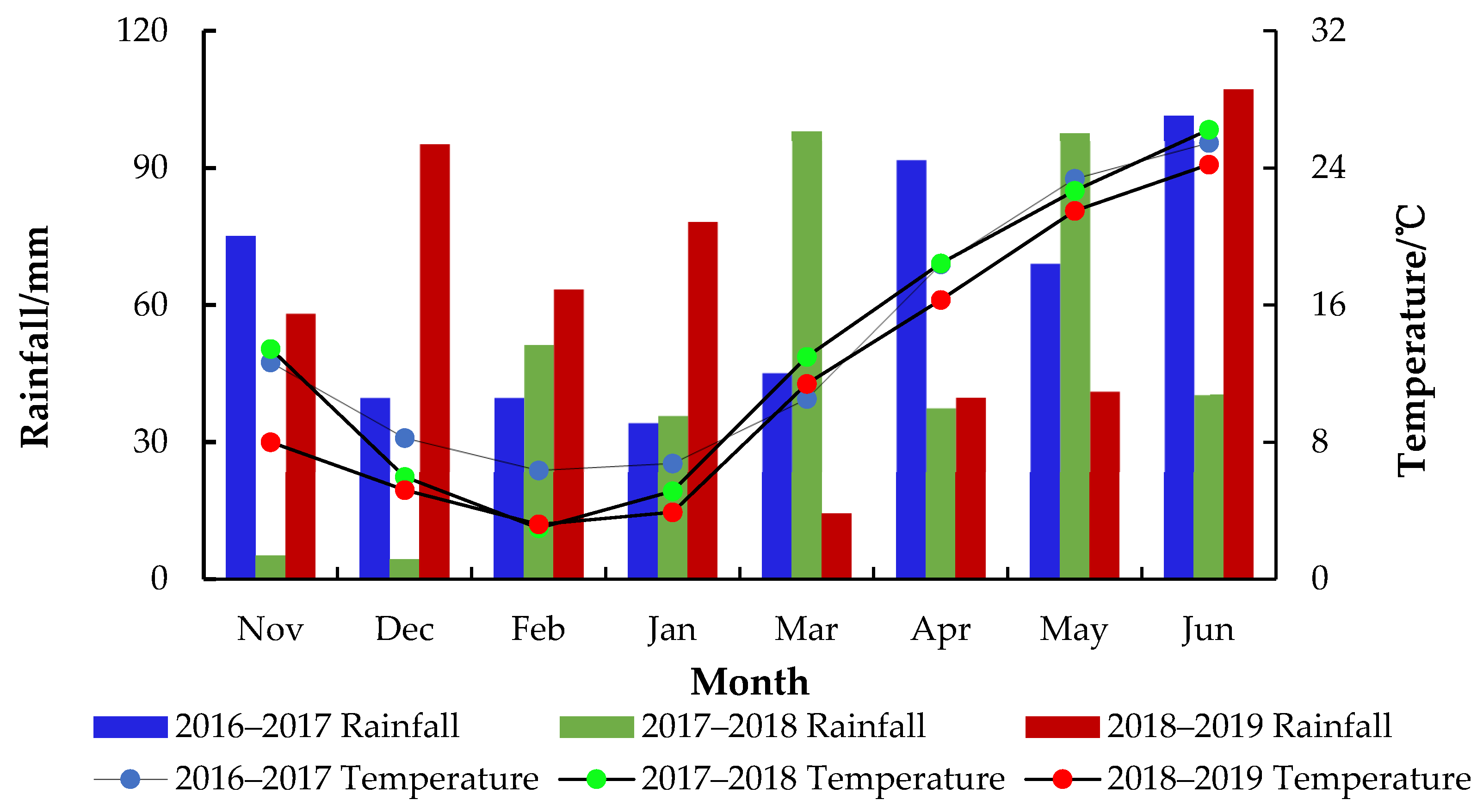
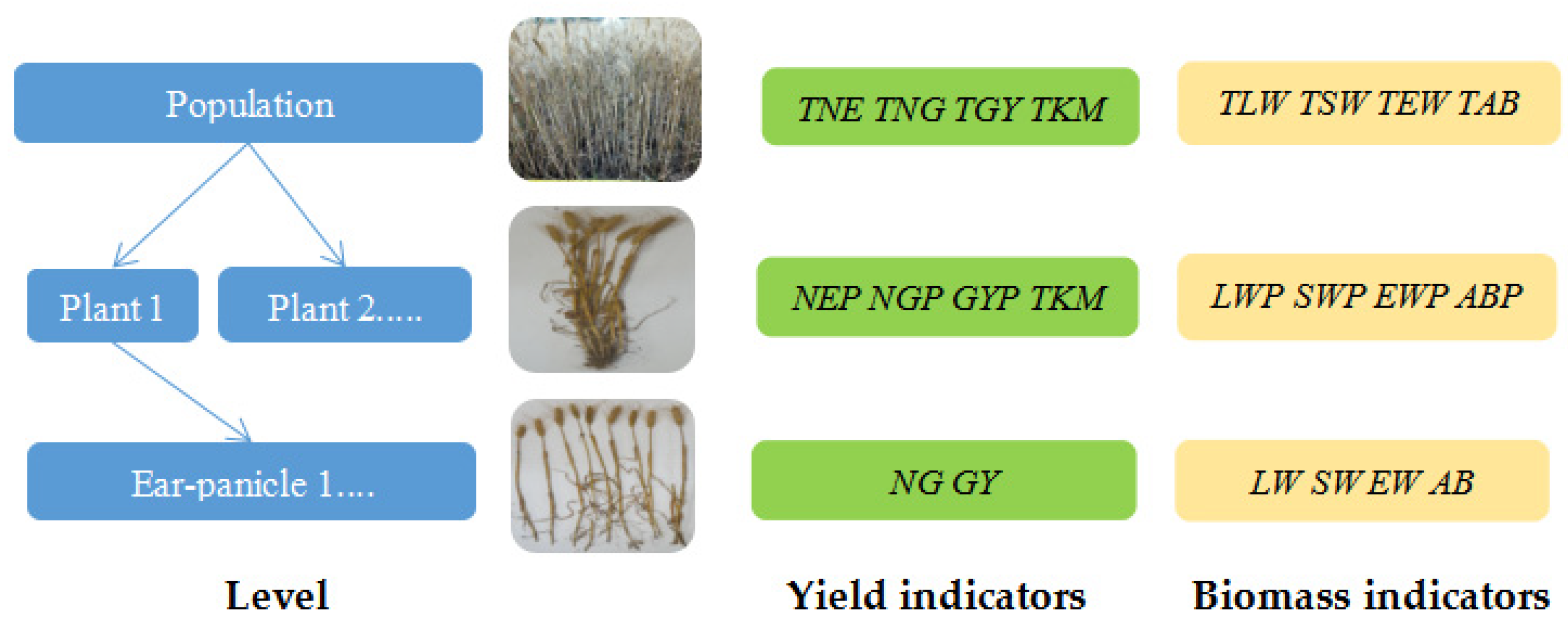

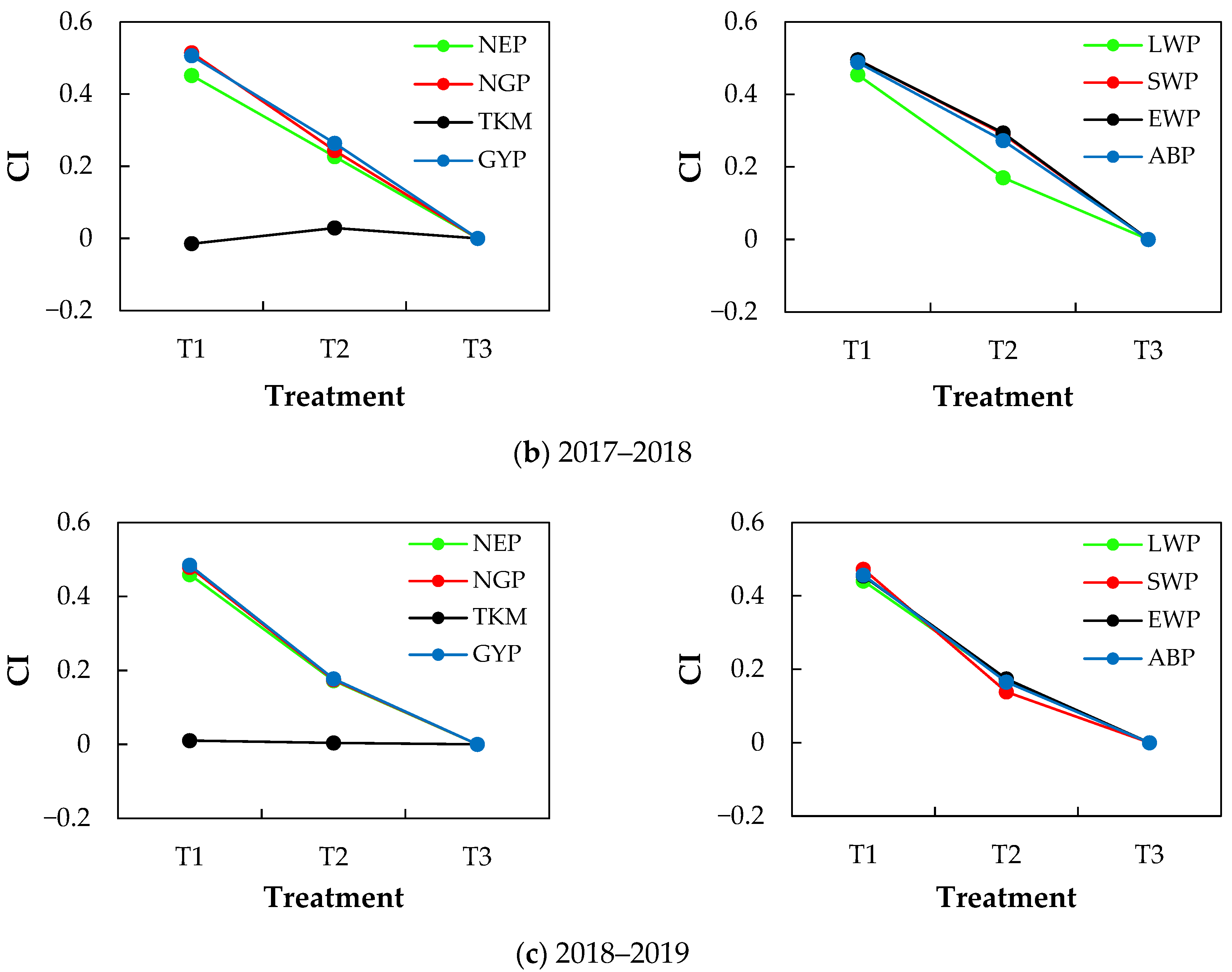

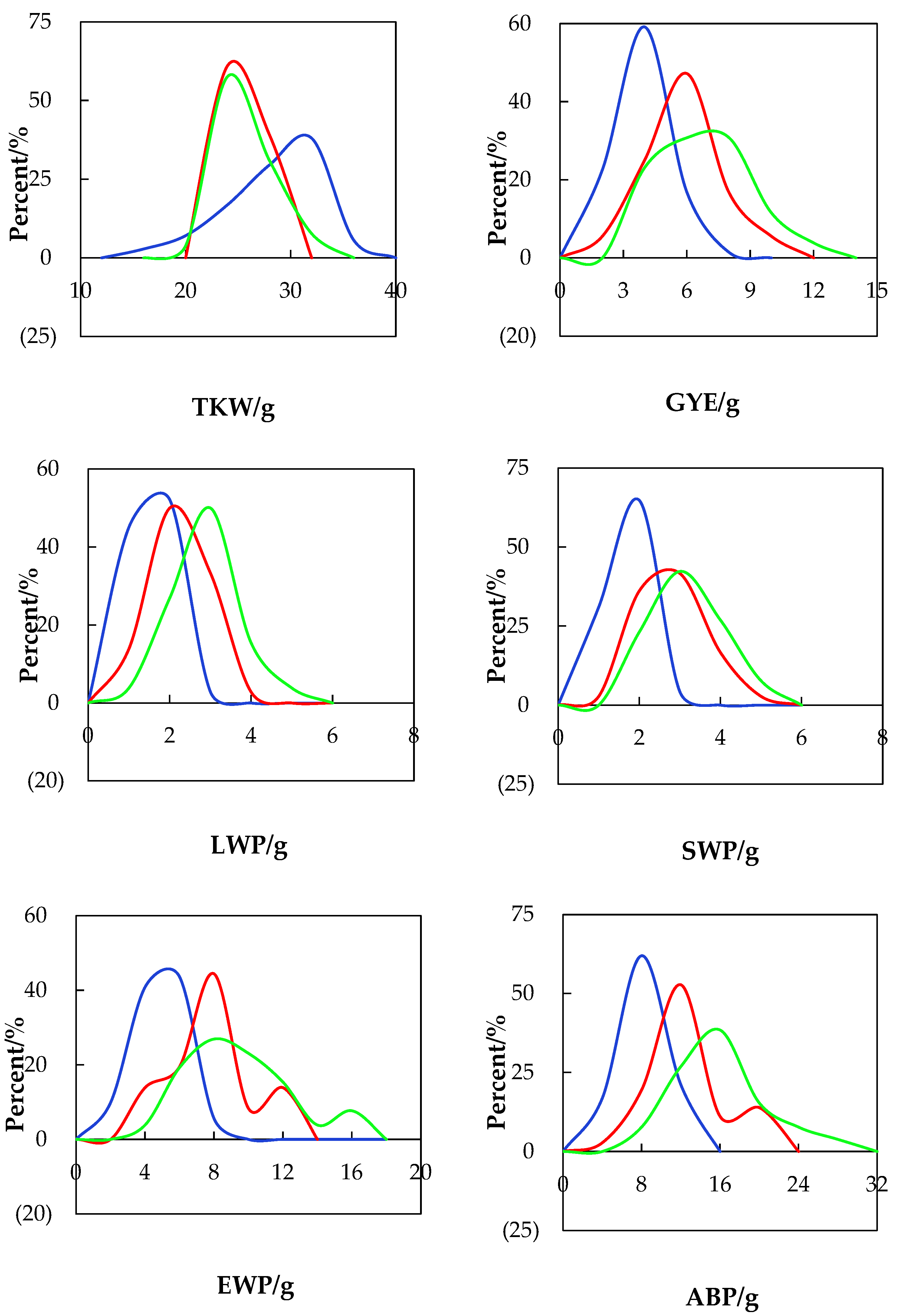
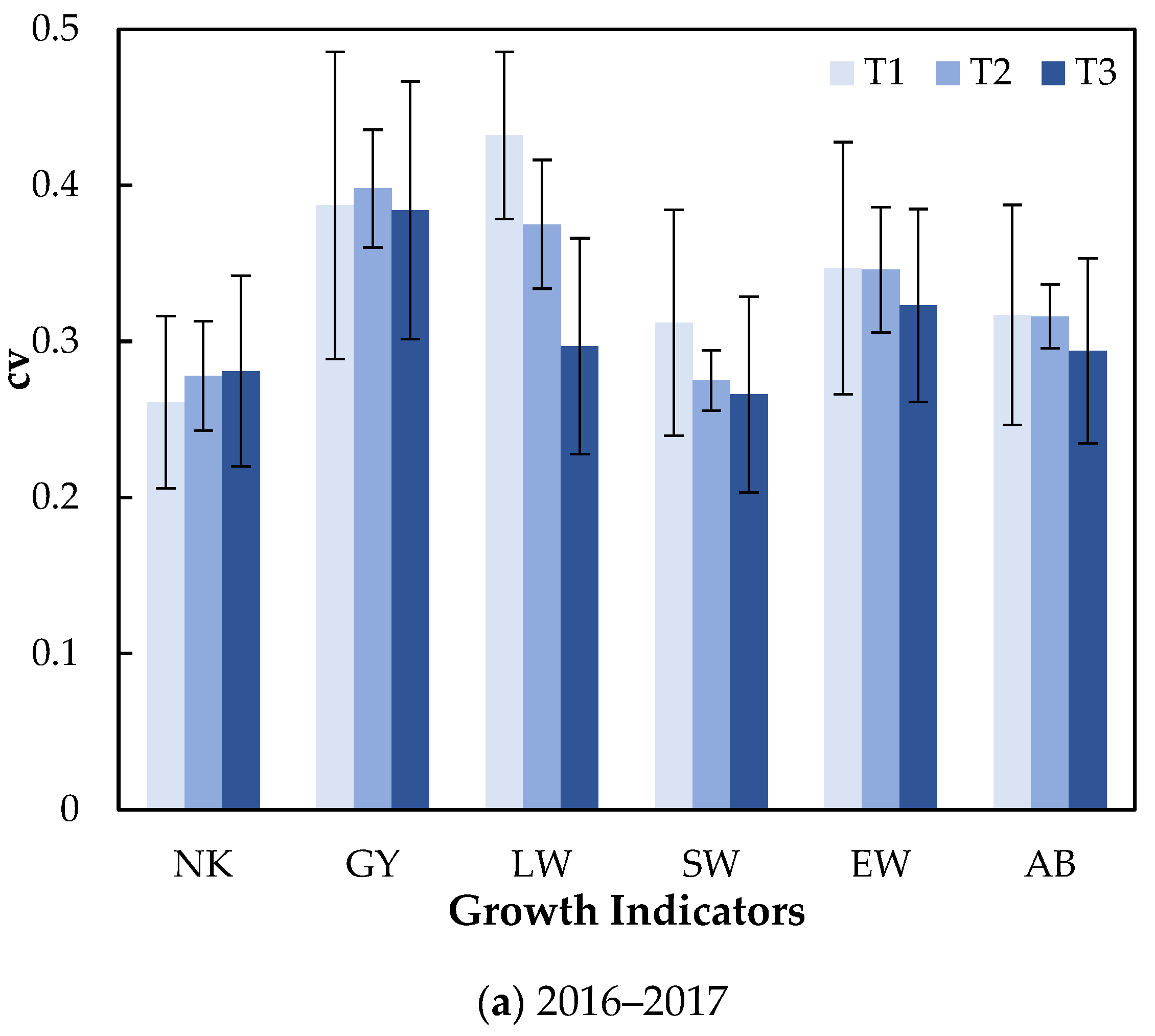
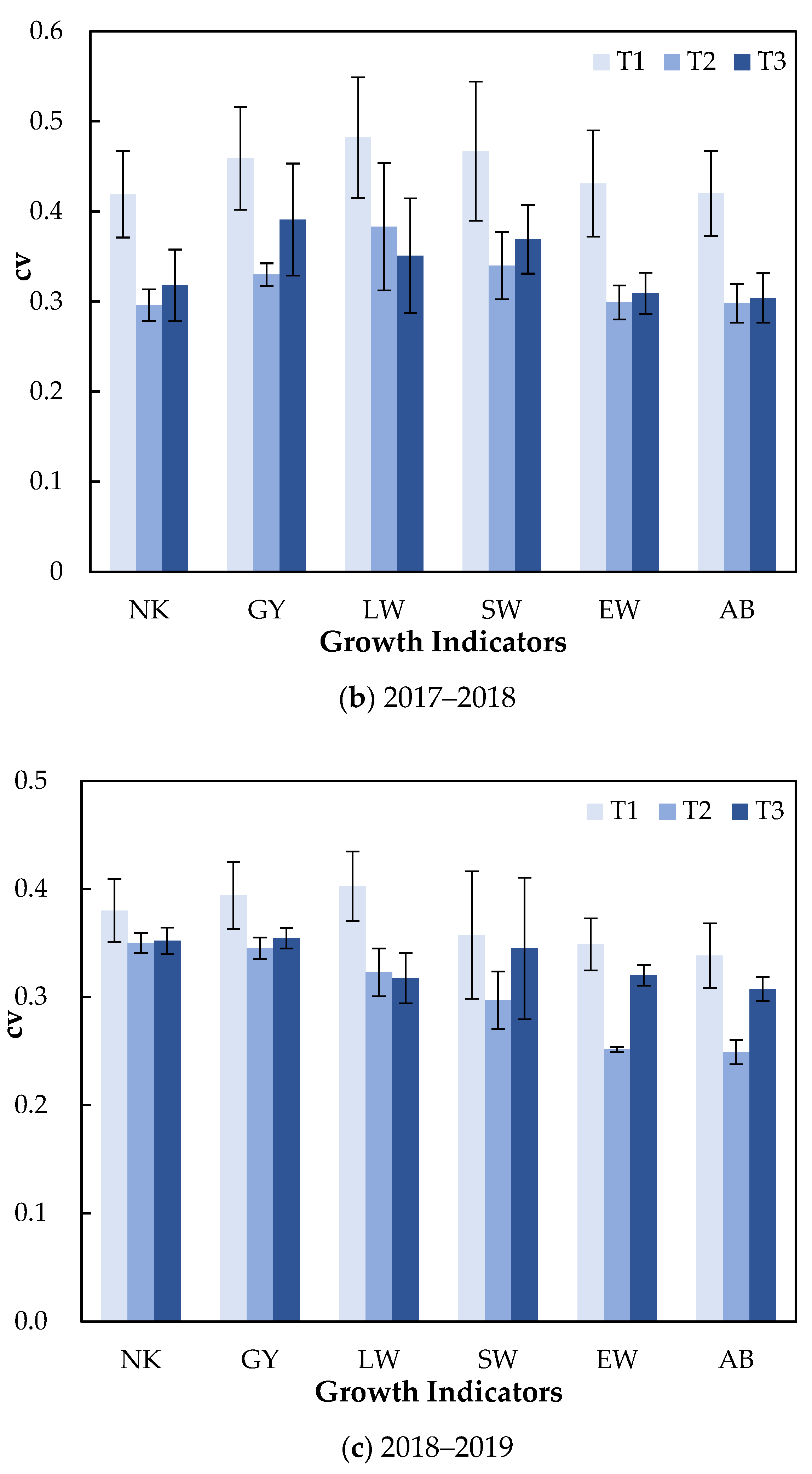
| Soil Depth/cm | Soil Bulk Density/(g·cm−3) | Moisture Content/% | Soil Porosity/% |
|---|---|---|---|
| 0–5 | 1.24 | 36.32 | 53.21 |
| 5–10 | 1.27 | 34.47 | 52.08 |
| 10–15 | 1.34 | 32.82 | 49.43 |
| 15–20 | 1.55 | 25.43 | 41.51 |
| 20–25 | 1.56 | 24.97 | 41.13 |
| 25–30 | 1.58 | 23.86 | 40.38 |
| Year | Treatment | TNE (104·hm−2) | TNG (104·hm−2) | TKM (g) | TGY (kg·hm−2) |
|---|---|---|---|---|---|
| 2016–2017 | T1 | 500.0 ± 43.6 a | 22,566.7 ± 2023.3 ab | 26.5 ± 1.8 a | 5972.9 ± 302.0 a |
| T2 | 508.3 ± 47.9 a | 24,352.8 ± 1407.5 a | 23.8 ± 1.1 a | 5787.4 ± 359.3 a | |
| T3 | 400.0 ± 46.4 b | 19,602.8 ± 1922.5 b | 23.9 ± 1.6 a | 4652.5 ± 201.4 b | |
| 2017–2018 | T1 | 468.5 ± 28.5 a | 16,274.1 ± 280.8 ab | 37.7 ± 0.6 a | 6136.9 ± 108.7 a |
| T2 | 435.2 ± 21.0 a | 16,694.4 ± 819.4 a | 36.1 ± 1.9 a | 6016.4 ± 112.6 a | |
| T3 | 361.1 ± 24.2 b | 14,316.7 ± 1343.1 b | 37.2 ± 1.7 a | 5301.4 ± 284.9 b | |
| 2018–2019 | T1 | 472.2 ± 11.1 a | 17,588.9 ± 640.6 a | 35.7 ± 0.3 a | 6271.8 ± 180.8 a |
| T2 | 459.3 ± 13.2 a | 17,772.2 ± 300.4 a | 35.9 ± 0.5 a | 6387.6 ± 104.7 a | |
| T3 | 400.0 ± 5.6 b | 15,477.8 ± 428.4 b | 36.0 ± 0.2 a | 5578.1 ± 127.8 b | |
| Year | ** | * | *** | *** | |
| Density | *** | * | ns | *** | |
| Year × density | ns | * | ns | ns | |
| Year | Treatment | TLW (kg·hm−2) | TSW (kg·hm−2) | TEW (kg·hm−2) | TAB (kg·hm−2) |
|---|---|---|---|---|---|
| 2016–2017 | T1 | 2199.3 ± 462.5 a | 2577.5 ± 232.5 a | 7861.5 ± 715.5 a | 12,638.3 ± 1156.4 a |
| T2 | 2159.9 ± 319.4 a | 2666.2 ± 316.4 a | 8013.3 ± 639.4 a | 12,839.4 ± 1150.5 a | |
| T3 | 1779.8 ± 251.0 a | 2159.2 ± 85.6 b | 6661.8 ± 365.1 b | 10,600.9 ± 1254.6 a | |
| 2017–2018 | T1 | 2605.7 ± 505.9 a | 3193.6 ± 133.6 a | 9015.4 ± 526.5 a | 14,814.7 ± 952.9 a |
| T2 | 2661.5 ± 531.0 a | 2944.3 ± 148.0 ab | 8292.9 ± 501.8 ab | 13,898.9 ± 558.6 ab | |
| T3 | 2070.2 ± 349.9 a | 2703.2 ± 232.7 b | 7630.7 ± 676.5 b | 12,404.1 ± 1236.4 b | |
| 2018–2019 | T1 | 2330.7 ± 237.4 a | 3266.2 ± 154.7 a | 9098.2 ± 317.8 a | 14,695.1 ± 809.0 a |
| T2 | 2206.5 ± 200.4 a | 3402.9 ± 81.5 a | 8786.8 ± 255.3 a | 14,396.3 ± 550.9 a | |
| T3 | 1908.3 ± 107.9 a | 2836.0 ± 94.3 b | 7645.8 ± 354.6 b | 12,390.0 ± 508.7 b | |
| Year | ns | *** | *** | *** | |
| Density | ns | ** | *** | *** | |
| Year × Density | ns | ns | ns | ns | |
| Year | Treatments | NEP | NGP | TKM (g) | GYP (g) |
|---|---|---|---|---|---|
| 2016–2017 | T1 | 2.470 ± 0.170 c | 111.841 ± 4.790 c | 26.690 ± 2.718 a | 2.963 ± 0.324 c |
| T2 | 4.243 ± 0.133 b | 202.967 ± 8.796 b | 23.593 ± 1.055 a | 4.834 ± 0.274 b | |
| T3 | 4.987 ± 0.472 a | 245.862 ± 18.688 a | 23.807 ± 0.267 a | 5.831 ± 0.488 a | |
| 2017–2018 | T1 | 2.348 ± 0.164 c | 81.492 ± 3.321 c | 37.713 ± 0.565 a | 3.074 ± 0.166 c |
| T2 | 3.312 ± 0.064 b | 127.061 ± 2.191 b | 36.096 ± 1.873 a | 4.588 ± 0.300 b | |
| T3 | 4.283 ± 0.301 a | 167.918 ± 11.649 a | 37.173 ± 2.730 a | 6.229 ± 0.420 a | |
| 2018–2019 | T1 | 2.657 ± 0.076 c | 99.000 ± 4.719 c | 35.720 ± 0.232 a | 3.530 ± 0.152 c |
| T2 | 4.067 ± 0.103 b | 156.820 ± 2.282 b | 35.952 ± 0.543 a | 5.635 ± 0.161 b | |
| T3 | 4.914 ± 0.209 a | 190.019 ± 2.796 a | 36.090 ± 0.163 a | 6.849 ± 0.117 a | |
| Year | *** | *** | *** | *** | |
| Density | *** | *** | ns | *** | |
| Year × Density | ns | * | ns | ns | |
| Year | Treatments | LWP (g) | SWP (g) | EWP (g) | ABP (g) |
|---|---|---|---|---|---|
| 2016–2017 | T1 | 1.087 ± 0.354 b | 1.278 ± 0.036 c | 3.901 ± 0.294 c | 6.266 ± 0.171 c |
| T2 | 1.796 ± 0.331 a | 2.230 ± 0.164 b | 6.665 ± 0.276 b | 10.691 ± 0.287 b | |
| T3 | 2.391 ± 0.327 a | 2.701 ± 0.292 a | 8.342 ± 0.586 a | 13.434 ± 1.011 a | |
| 2017–2018 | T1 | 1.323 ± 0.548 b | 1.600 ± 0.094 c | 4.514 ± 0.182 c | 7.437 ± 0.57 c |
| T2 | 2.012 ± 0.279 ab | 2.251 ± 0.263 b | 6.320 ± 0.312 b | 10.582 ± 0.298 b | |
| T3 | 2.424 ± 0.338 a | 3.173 ± 0.239 a | 8.949 ± 0.528 a | 14.546 ± 1.065 a | |
| 2018–2019 | T1 | 1.309 ± 0.293 b | 1.837 ± 0.143 c | 5.121 ± 0.158 c | 8.267 ± 0.034 c |
| T2 | 1.944 ± 0.240 a | 3.002 ± 0.072 b | 7.757 ± 0.136 b | 12.703 ± 0.174 b | |
| T3 | 2.341 ± 0.344 a | 3.484 ± 0.171 a | 9.389 ± 0.213 a | 15.213 ± 0.353 a | |
| Year | ns | *** | *** | *** | |
| Density | *** | *** | *** | *** | |
| Year × Density | ns | ns | ns | ns | |
| Year | Treatment | NK | GY (g) | LW (g) | SW (g) | EW (g) | AB (g) |
|---|---|---|---|---|---|---|---|
| 2016–2017 | T1 | 45.489 ± 4.857 a | 1.209 ± 0.214 a | 0.436 ± 0.133 a | 0.520 ± 0.055 a | 1.589 ± 0.248 a | 2.545 ± 0.244 a |
| T2 | 48.093 ± 1.915 a | 1.145 ± 0.031 a | 0.427 ± 0.099 a | 0.528 ± 0.024 a | 1.581 ± 0.116 a | 2.536 ± 0.161 a | |
| T3 | 49.284 ± 5.555 a | 1.172 ± 0.093 a | 0.484 ± 0.030 a | 0.541 ± 0.022 a | 1.677 ± 0.102 a | 2.702 ± 0.102 a | |
| 2017–2018 | T1 | 34.749 ± 3.199 a | 1.310 ± 0.045 a | 0.554 ± 0.203 a | 0.682 ± 0.007 a | 1.925 ± 0.060 a | 3.160 ± 0.146 a |
| T2 | 38.363 ± 0.563 a | 1.384 ± 0.065 a | 0.609 ± 0.095 a | 0.679 ± 0.068 a | 1.908 ± 0.073 a | 3.195 ± 0.066 a | |
| T3 | 39.225 ± 1.659 a | 1.455 ± 0.054 a | 0.565 ± 0.064 a | 0.741 ± 0.081 a | 2.092 ± 0.106 a | 3.398 ± 0.269 a | |
| 2018–2019 | T1 | 37.386 ± 3.747 a | 1.333 ± 0.058 a | 0.495 ± 0.049 a | 0.695 ± 0.057 a | 1.934 ± 0.060 a | 3.124 ± 0.133 a |
| T2 | 39.494 ± 1.579 a | 1.419 ± 0.043 a | 0.490 ± 0.022 a | 0.756 ± 0.043 a | 1.953 ± 0.035 a | 3.199 ± 0.056 a | |
| T3 | 41.595 ± 1.513 a | 1.499 ± 0.066 a | 0.512 ± 0.059 a | 0.763 ± 0.054 a | 2.055 ± 0.082 a | 3.330 ± 0.164 a |
Disclaimer/Publisher’s Note: The statements, opinions and data contained in all publications are solely those of the individual author(s) and contributor(s) and not of MDPI and/or the editor(s). MDPI and/or the editor(s) disclaim responsibility for any injury to people or property resulting from any ideas, methods, instructions or products referred to in the content. |
© 2024 by the authors. Licensee MDPI, Basel, Switzerland. This article is an open access article distributed under the terms and conditions of the Creative Commons Attribution (CC BY) license (https://creativecommons.org/licenses/by/4.0/).
Share and Cite
Li, H.; Korohou, T.; Liu, Z.; Geng, J.; Ding, Q. Analysis of Multiangle Wheat Density Effects Based on Drill Single-Seed Seeding. Agriculture 2024, 14, 176. https://doi.org/10.3390/agriculture14020176
Li H, Korohou T, Liu Z, Geng J, Ding Q. Analysis of Multiangle Wheat Density Effects Based on Drill Single-Seed Seeding. Agriculture. 2024; 14(2):176. https://doi.org/10.3390/agriculture14020176
Chicago/Turabian StyleLi, Haikang, Tchalla Korohou, Zhenyu Liu, Jing Geng, and Qishuo Ding. 2024. "Analysis of Multiangle Wheat Density Effects Based on Drill Single-Seed Seeding" Agriculture 14, no. 2: 176. https://doi.org/10.3390/agriculture14020176
APA StyleLi, H., Korohou, T., Liu, Z., Geng, J., & Ding, Q. (2024). Analysis of Multiangle Wheat Density Effects Based on Drill Single-Seed Seeding. Agriculture, 14(2), 176. https://doi.org/10.3390/agriculture14020176





